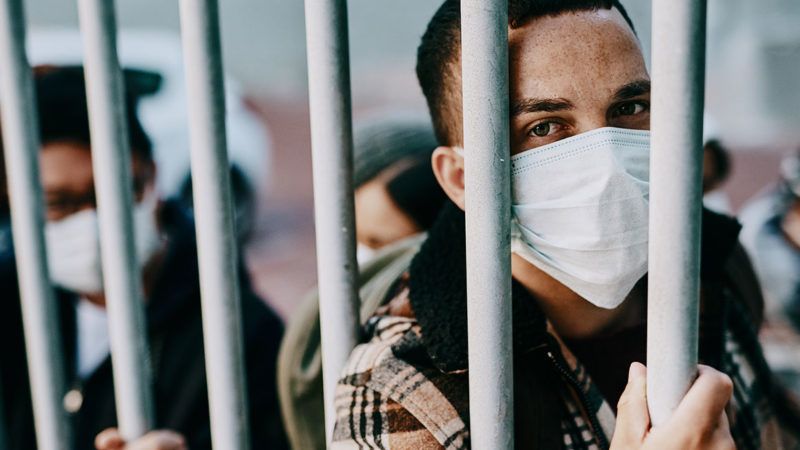COVID-19 Pulls Back the Mask on America's Prison System
This deadly and contagious disease has exposed problems with prison systems that have been ignored for decades.

As of May 30, more than 300 incarcerated people across the United States have died from COVID-19. Victims of the virus include a woman who was sent to federal prison during her third trimester of pregnancy, a Michigan man who was two weeks away from release, and a wheelchair-bound 67-year-old man with no legs who died in a hospital two days after his release date. None of these prisoners were sentenced to death.
When the pandemic first hit, an unusual alliance of civil liberties groups, public defenders, and prison guard unions warned that prisons and jails were ill-equipped to handle the problem. They knew better than anyone that a deadly and contagious disease would expose problems with prison systems that have been ignored for decades.
U.S. prisons and jails are opaque, crowded, filthy institutions where the preferred administrative pace is glacial. They have been finely tuned over the past 50 years to resist outside oversight and sudden change.
As the virus began to spread domestically, many jurisdictions took unprecedented steps to reduce their incarcerated populations, such as halting intake of new inmates and releasing people who had been held in jail for minor offenses. Still, these efforts barely put a dent in the total number of incarcerated people. A May report from the Vera Institute, a nonprofit focused on justice reform, found that federal, state, and local prison populations had decreased by only 1.6 percent in the first few months of 2020 and that the incarcerated populations in five states had actually increased. "Data from 44 states and the Bureau of Prisons show that none had moved with the urgency required to meet the recommendations of public health officials to reduce incarceration," the report concluded.
Criminal justice advocates and families of inmates say the federal Bureau of Prisons (BOP) only halfheartedly complied with a March directive from Attorney General William Barr to grant compassionate release and home confinement to elderly and at-risk inmates. There was confusion surrounding which federal inmates were eligible. Federal prisons across the country told inmates they were going home and put them in pre-release quarantine, only to later tell them they no longer qualified.
By late April, eight of the top 10 biggest clusters of COVID-19 cases in the country were in prisons or jails. In the first week of May, The Marshall Project, a nonprofit newsroom, reported that more than 20,000 inmates across the country had been infected and 304 had died.
Individual inmates and groups such as the American Civil Liberties Union filed a flurry of lawsuits seeking immediate relief. In May, a U.S. District Court judge ordered officials at FCI Danbury, a federal prison in Connecticut, to drastically speed up their process for identifying and releasing at-risk inmates. Noting that the Danbury warden hadn't approved a single one of the 241 inmate petitions for compassionate release following Barr's memo, the judge found that these delays and failures amounted "to deliberate indifference to a substantial risk of serious harm to inmates in violation of the Eighth Amendment." Another federal judge ordered the BOP to relocate elderly inmates at an Ohio federal prison riddled with infections.
But many state and federal courts have resisted lawsuits' sweeping demands for large-scale transfers or releases. In May, the U.S. Supreme Court ruled against inmates at a geriatric prison in Texas, who had filed a lawsuit claiming the unsanitary, crowded conditions and lack of hand sanitizer violated their constitutional rights. The high court ruled that the inmates hadn't exhausted their "administrative remedies" under the Prison Litigation Reform Act (PLRA), which requires inmates to go through prisons' lengthy and confusingly complex grievance processes before they can file a lawsuit.
"It has long been said that a society's worth can be judged by taking stock of its prisons," Justice Sonia Sotomayor wrote in a statement accompanying the Court's order. "That is all the truer in this pandemic, where inmates everywhere have been rendered vulnerable and often powerless to protect themselves from harm. May we hope that our country's facilities serve as models rather than cautionary tales."
Hope is nice, but it's no substitute for oversight. In April, several inmates at the Miami-Dade County Jail filed a lawsuit challenging that facility's unsanitary conditions. One of the plaintiffs, Anthony Swain, has been incarcerated for four years while awaiting trial because he can't afford bail. In mid-May, Swain, who is paraplegic, tested positive for COVID-19.
Show Comments (34)